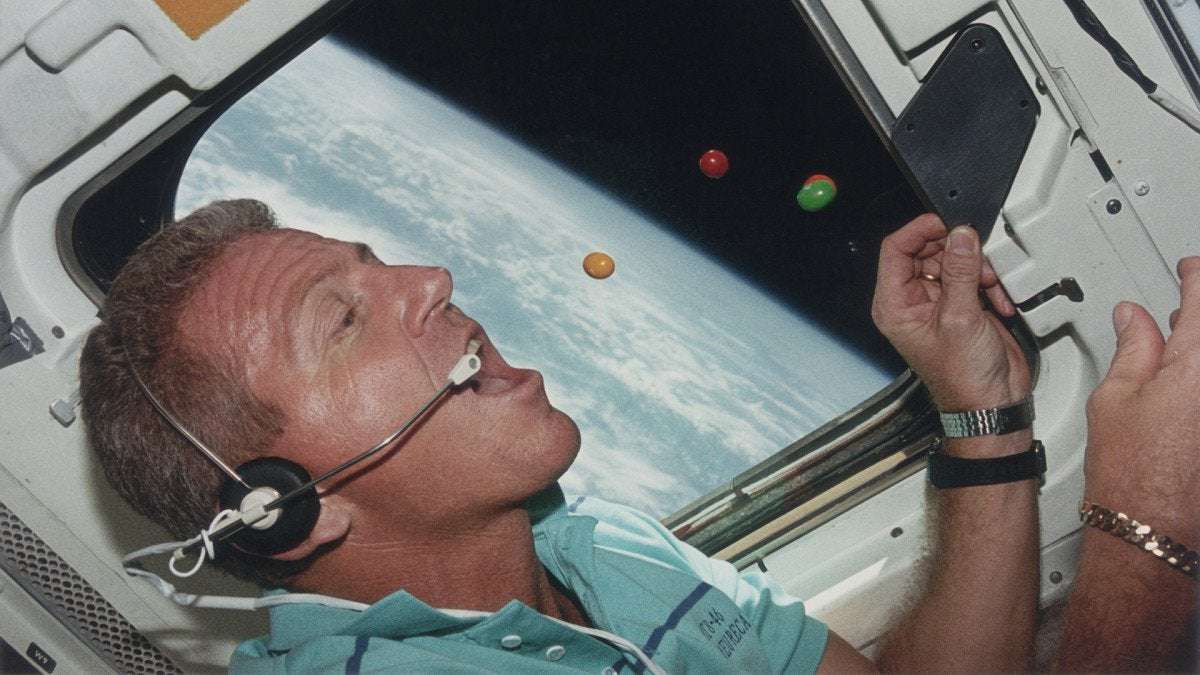M&Ms were first released in 1941, and since then have had an oversized impact on American popular culture. From their beginnings as snacks for World War II soldiers, to their time aboard both the first and last NASA space missions, here are some of the highlights in their long history.
1. M&Ms were inspired by rations given to soldiers during the Spanish Civil War.
In 1932, after a falling out with his father and business partner, Forrest Mars Sr. of the Mars candy company moved to England, where he began manufacturing Mars bars for troops. It was during the Spanish Civil War that Mars purportedly encountered British volunteers eating small chocolate beads encased in a hard sugar shell, which prevented melting. In an age when sales of chocolate typically dropped off during summer months due to the lack of air conditioning, Mars was thrilled by the prospect of developing a product that would be able to resist melting in high temperatures.
2. M&Ms used to be made with Hershey's chocolate, now one of Mars' biggest competitors.
Upon Mars' return to the United States, he approached Bruce Murrie, the son of Hershey executive William Murrie, to join him in a new business venture. Anticipating a shortage of chocolate and sugar as World War II raged on in Europe, Mars sought a partnership that would ensure a steady supply of resources needed to produce his new candy. In return, Murrie received a 20 percent stake in the M&M product, which was named to represent ‘Mars’ and ‘Murrie.’
3. During World War II, M&Ms were exclusively sold to the U.S. military.
In March of 1941, Mars was granted a patent for his manufacturing process and production began in Newark, New Jersey. Originally sold in cardboard tubes, M&Ms were covered with a brown, red, orange, yellow, green or violet coating. After the U.S. entered the war, the candies were exclusively sold to the military, enabling the heat-resistant and easy-to-transport chocolate to be included in American soldiers’ rations. By the time the war was over and GIs returned home, they were hooked.
READ MORE: How Hershey's Chocolate Helped Power Allied Troops During WWII
4. M&Ms didn't have their signature "M" stamp until 1950.
Urbano Delvalle/The LIFE Images Collection/Getty Images
Shortly after wartime quotas ended and the candies were made available to the general public, Forrest Mars bought out Murrie’s shares in the company and took sole ownership of the M&M brand. The familiar brown bag package that remains in use today was introduced in 1948. Two years later, the candies began to be imprinted with a black “m” (which changed to white in 1954), and customers were encouraged to “Look for the M on every piece” to ensure they were getting the real thing.
5. Between 1976 and 1987, there were no red M&Ms.
In the early 1970s, a bombshell Russian study was released linking FD&C Red No. 2—then the most widely used commercial food dye in America—to cancer and fetal death. Following more studies, the Food and Drug Administration banned its use in 1976. Although the red food coloring in question was not actually used in M&Ms, Mars removed red candies from the color mix to avoid consumer confusion. Following public demand, they were re-introduced in 1987—by which time Red Dye No. 2 was proven not to be carcinogenic, after all.
6. M&Ms were the first candy to go to space.
Astronaut Loren J. Shriver, Mission Commander of STS-46, eats floating M&M's on the flight deck of the shuttle Atlantis during its orbit of the earth in 1992. Space Frontiers/Getty Images
The same qualities that made them durable wartime rations made them perfect for space travel. So on request from the crew aboard NASA’s first space shuttle, Columbia, M&M’s became the first candy to rocket into space in 1981. To commemorate NASA's final space shuttle launch in 2011, Mars even made special-edition M&Ms just for the flight, decorated with images of the Atlantis shuttle, the phrase "3, 2, 1...Lift Off!" and date of the launch: July 8, 2011.
READ MORE: The Evolution of Space Food

minneapple79 on February 26th, 2021 at 17:21 UTC »
The other fun fact with M&Ms is that M&M/Mars wouldn't let Spielberg use them in E.T. (the scene where Elliot uses candy to lure ET out of the shed). Spielberg then went to Hershey, which was struggling to market Reese's Pieces. They put Reese's in the movie and bam, Reese's sales exploded that summer.
ghostinawishingwell on February 26th, 2021 at 16:16 UTC »
Kind of like how they made those special heat resistant hershey's bars during desert storm. Then they started selling them in stores. They were terrible but they didn't melt!
open_door_policy on February 26th, 2021 at 15:46 UTC »
Melts in your mouth, not in your c-rations.